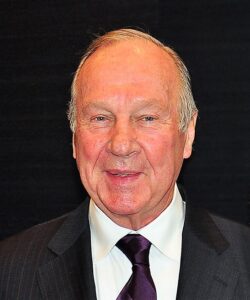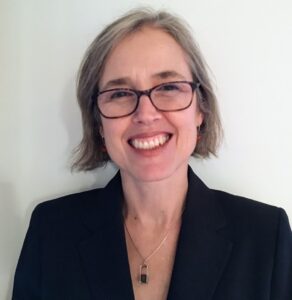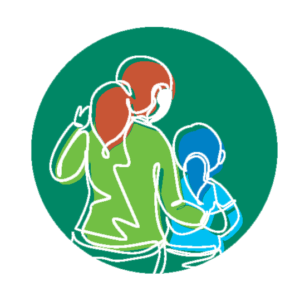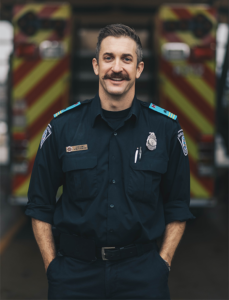Subscribe to Catalyst
Subscribe to get our magazine delivered right to your inbox
Related Articles
New policy brief underscores the plight of parenting in a pandemic
There is a “secret society” at the Mental Health Commission of Canada (MHCC), just like there is at every workplace across the country. Its members recognize each other through various signs and signals — some subtle, others less so.
Do you take calls in the blessed quiet of a car, in the bedroom closet, or in the relative peace of the furnace room? Are you the person at the meeting who switches off your camera so you can pour a bowl of goldfish crackers and offer feedback on an indiscernible drawing of a cat (or is it a crow)? Do you hear yourself saying, “I’ll help you find your shoe/bunny/imperceptibly tiny Lego accessory as soon as I finish writing this report/booking this meeting/drafting this article”?
If your answer to any of these questions is yes, chances are you’re part of the club.
Parents of young children have borne the brunt of COVID-19 stress — mothers especially. Consider new research from the MHCC (in partnership with the Canadian Paediatric Society), which found rates of depression during the pandemic among mothers of infants and children (age 18 months to eight years) rising to 42 per cent from nine per cent.
A growing need
Even before COVID-19, signs that we needed to rethink the services and supports available to families were already appearing, especially among those facing the additional stressors of financial insecurity, low social support, or racial discrimination. Pre-pandemic, less than 20 per cent of families had access to the greatest equalizer of disparities in the early years: affordable, licensed, early childhood education centres.
Since the pandemic began, families have been forced to deal with an additional range of unplanned complications, from social isolation and disruptions in child care and schooling to financial worries and loss of employment. Unsurprisingly, the result has been increased family conflict, including divorce.
My colleague, a parent who works in the MHCC’s Public Affairs department, is no stranger to this reality. “At the onset of the pandemic, I lost my mom, my husband lost his job, and my children lost their routine,” she explained. “There is no doubt in my mind that the adverse experiences parents are contending with have a trickle-down effect when it comes to children’s well-being.”
Her anecdotal findings are corroborated by the 40 per cent of Ontario parents who report behavioural and emotional changes in their children and the 61 per cent of parents across Canada who are concerned about managing their child’s behaviour, anxiety, emotions, and stress.
The search for new solutions
When looking at solving these real-world problems, our joint policy brief makes specific recommendations for decision makers to consider.
“We need targeted mental health supports for parents of young children,” said Brandon Hey, MHCC Policy and Research senior analyst. “And we need interventions that reduce parental stress and support caregiving needs.”
On that score, the Wellness Together Canada (2020-2024) portal is a great place for parents to start. Even before signing up for an account, basic information on managing anxiety for adults and children is readily available. With an account, you have access to an even broader array of resources, including evidence-based behavioural management courses, one-on-one (or group) counselling, and self-guided programs that allow you to track your state of mind.
Support starts with speaking up
My colleague who lived with mental illness prior to the pandemic, has seen her anxiety spike. “The other day I got an alert on my activity tracker. It told me my heart rate was through the roof but had the ‘sense’ to recognize I wasn’t exercising. Sometimes a mental health problem is as obvious as a flashing alarm on your watch, yet with others it’s more insidious.”
That’s why, affirmed Hey, we need measures that address short-term challenges while also considering how to create policies that improve outcomes down the road, such as early education, child care, income supplements, and protections from discrimination.
“The pandemic has exacerbated pre-existing service gaps and inequities,” he added. “The wait times are too long, the number of qualified practitioners too few, and the accountability measures too weak.”
“The struggle parents face is very real,” said my colleague. “No one does their best parenting under duress, and we know that when stress builds we run the risk of modelling less than perfect behaviour or show less than ideal coping strategies, which can have serious implications for our kids. But there is no shame at all in saying, ‘Look, I need help, I’m not OK.’”
And when people do reach out, said Hey, we need to make sure that that the right person is there to answer the call.
Suzanne Westover
An Ottawa writer and former speechwriter, and Manager of Communications at the Mental Health Commission of Canada. A homebody who always has her nose in a book, she bakes a mean lemon loaf (some would call her a one-dish wonder) and enjoys watching movies with her husband and 13-year-old daughter. Suzanne’s time with the MHCC cemented her interest in mental health, and she remains a life-long learner on the subject.
Subscribe to Catalyst
Subscribe to get our magazine delivered right to your inbox
Related Articles
New virtual Mental Health First Aid course teaches adults to support the youth in their lives
Long before the pandemic, the need to support the mental health of young people was evident. With 50 per cent of all mental health problems established by age 14, the formative years of our youth are some of the most vulnerable. Now, by also having to face the impacts of COVID-19, that vulnerability in our youth has only grown.
For adults, it can be difficult to know how to relate to the young people in their lives, let alone how approach them about their mental well-being. To help open up those important conversations, the Mental Health Commission of Canada’s (MHCC’s) updated its MHFA Supporting Youth training and adapted it to a virtual format — and, as adults may be surprised to learn, “relating” isn’t part of the curriculum.
“When you’re talking to a young person about their experiences, it’s not about you,” explained Denise Waligora, a training and delivery specialist at the MHCC. “By the time you’re an adult, you’ve overcome hardship, and learned coping strategies along the way. The same isn’t necessarily true of youth. You have to be able to listen without minimizing their experiences or comparing them to your own.”
That kind of non-judgmental listening is just one of the strategies participants can expect to pick up from the new Mental Health First Aid virtual training. During the highly interactive 10-hour course, they will also learn how to recognize the signs of declining mental well-being and engage in conversations about those observations, assist in mental health or substance use crises, seek outside supports, and care for themselves as a “first aider.”
Focusing on the individual
Rather than offering a step-by-step approach to supporting all youth, course facilitators emphasize the role individuality plays. “Everyone has a baseline set of behaviours, moods, and attitudes,” said Waligora; for example, while one young person’s declining mental health could manifest in low grades or conflicts with friends, those things could be the norm for someone else.
The most important factor to be aware of, she said, is change. “As soon as we recognize a shift in any of these areas, we need to ask, How big of a deviation is this from that person’s baseline and how long has it been going on?”
In a similar way, effective conversational strategies and types of support may also vary depending on the individual. While some youth might be eager to share their feelings if given the opportunity, others may feel embarrassed and need more time. To help create a comfortable atmosphere, course participants are taught to approach youth more casually while engaging in an activity, as opposed to confronting them head-on.
“Whether it takes one try or five, you’re showing that young person someone cares about them.”
An updated approach
While the updates to MHFA Supporting Youth were based on the original in-person course, the content has undergone more than a virtual makeover.
One key addition, says Waligora, is a section dedicated to marginalized groups, including racialized, Indigenous, and 2SLGBTQ+ youth. “A young person from the 2SLGBTQ+ community may have a very different high school experience than their peers, for example. We have to learn about and acknowledge those differences to provide the most effective support.”
Another aspect of effective support (and further addition to the course content) is self-care for first aiders themselves. While participants are largely trained to support the youth around them, they are also taught to acknowledge the toll caring for others can take on one’s own well-being.
Finally, the updated course has shifted to include a more holistic approach to wellness. Rather than focusing on labels, the training follows a recovery-oriented model, emphasizing resilience and overall well-being in all areas of life.
Our collective responsibility
While the course was built for adults who interact with youth, as Waligora points out, that group extends far beyond parents.
“Almost all of us have young people in our lives, whether it’s relatives, neighbours, students, or employees. If you’re close enough to notice a change in a person, you’re close enough to offer your support.”
Late last year, the government of Saskatchewan echoed that sentiment by committing $400,000 to provide MHFA training in K-12 schools across the province.
“Our goal is to have at least one staff member in each school receive Mental Health First Aid training by December 2021,” said Saskatchewan Education Minister Dustin Duncan. “We are excited to support schools in ensuring students have access to mental health resources, and I encourage all provincial school divisions to take part to help remove the stigma around mental health.”
For Waligora, the bottom line is simple: “We have a responsibility to protect our youth. Every young person deserves a safe place to turn. As adults, we can be that place.”
Amber St. Louis
Subscribe to Catalyst
Subscribe to get our magazine delivered right to your inbox
Related Articles
MHCC marks the retirement of Phil Upshall
Soon after Louise Bradley was named president and CEO of the Mental Health Commission of Canada (MHCC) more than 10 years ago, she began to surround herself with a leadership team that could guide the organization with the wisdom of lived experience.
According to Bradley, a big part of that plan took the form of an “irrepressible, intelligent, highly opinionated, gold-hearted, self-deprecating, one-of-a-kind adviser” by the name of Phil Upshall, who, she added, was “someone who would make sure the voice of lived experience was front and centre.”
When they first met, Upshall was part of a circle of influential mental health thought leaders “who were well ahead of their time,” she said. “They had their finger on the pulse of the economic and human cost of mental illness long before awareness campaigns were in fashion.”

Phil Upshall
But while Upshall had great tenacity and wide-ranging connections, what intrigued Bradley most was his own lived experience, which was accompanied by a willingness to freely share his story in the service of improving the lot of others.
Putting lived experience at the heart of decision making
Michel Rodrigue, who took over the MHCC helm from Bradley in March, agreed. “We can credit Phil not just for embedding an appreciation of lived experience into our leadership group, but for making the essential importance of being a conduit for lived experience central to its DNA.”
“Phil will grouse that I only took a third of his advice,” laughed Bradley. “But the fact is, Phil’s presence around the executive leadership table did more than hold us to account. He challenged our thinking, and when our approach diverged from his, he asked that we look him in the eye to provide a well-reasoned argument.”
For Ed Mantler, the MHCC’s vice-president of Programs and Priorities, Upshall provided sober second thought. “His lived experience reminded me that every piece of our work has real-world implications. Phil inspired me to be a greater champion for our work on recovery, and he opened my eyes to the importance of shining a light on peer support.”
Larger than life
“Phil made no apologies for this forthright manner,” reflected Bradley, whose recollections of Upshall were infused with deepest affection and respect.
“It gave me comfort,” said Mantler, “to know that our decisions were endorsed by someone whose agenda was in alignment with ours but whose opinions were squarely his own. Phil is a political animal, yet he is that rare breed who is able to make himself heard above the din of party politics.”
“In the mental health space generally, Phil was larger than life,” concurred Rodrigue. “He was instrumental in so many key advancements, from the creation of the Canadian Alliance on Mental Illness and Mental Health to championing the creation of the MHCC. But what I am left with, because of my personal interactions with Phil, is an openness to hearing hard truths — an appreciation of the strength it takes to be vulnerable.”
Rodrigue does not plan to stray far from those learnings. “Our Hallway Group, our Youth Council, our many staff members who embody grace and recovery, they all have stories that ground us, experiences that humble us, and wisdom that guides us. Phil has taught us to listen to those North Stars, and that will never change.”
A quiet legacy
While Upshall’s part in the MHCC’s success has been largely behind the scenes, that’s exactly why Bradley felt it has had the greatest impact.
“Phil never asked for credit, nor did he care about his contributions being heralded from the rooftops,” said Bradley. “All he ever wanted was for us to get it right. Phil’s tenure as a formal adviser to the MHCC may be winding down, but his friendship will never waver.”
As Upshall’s MHCC retirement begins, the organization is proud to celebrate his quiet legacy, which is just one small part of the indelible stamp he is leaving on Canada’s broader mental health landscape.
Suzanne Westover
An Ottawa writer and former speechwriter, and Manager of Communications at the Mental Health Commission of Canada. A homebody who always has her nose in a book, she bakes a mean lemon loaf (some would call her a one-dish wonder) and enjoys watching movies with her husband and 13-year-old daughter. Suzanne’s time with the MHCC cemented her interest in mental health, and she remains a life-long learner on the subject.
Subscribe to Catalyst
Subscribe to get our magazine delivered right to your inbox
Related Articles
New polling looks at realities of mental health and substance use workforce
For Dr. Mary Bartram, policy director at the Mental Health Commission of Canada (MHCC), gaining a better understanding of the realities of those who work in the field of mental health and substance use (MHSU) is key to unlocking improved mental health outcomes.
“For far too long, data about these essential care providers hasn’t been collected,” explained Bartram. “As we are bracing for an echo mental health pandemic, we have to understand the hidden workforce called upon to address it.”
Bartram noted that, while detailed data is regularly gathered about doctors and nurses, we only have a cursory understanding about psychologists and social workers and know almost nothing about all the other kinds of MHSU workers — from psychotherapists to addiction counsellors.
“Responding to the increased MHSU issues we are seeing as a result of the pandemic means knowing exactly what tools we have at our disposal,” said Bartram. “Yet we don’t know where this workforce works, how many hours of service its workers provide, which populations they serve, or what areas of expertise they have.” This lack of knowledge is concerning, given these workers’ unique position in responding to these emerging needs during the pandemic.

Mary Bartram
Shining a light into care gaps
Fortunately, this lack of understanding is beginning to change, with a recent survey conducted by the MHCC and the Canadian Health Workforce Network, which specifically set out to take a snapshot of this undiscovered landscape.
For Bartram, the numbers revealed in the Mental Health and Substance Use Workforce Capacity to Respond to COVID-19 Survey set off warning bells on several fronts.
“This survey lays bare the two-tiered nature of our system of care. Much as we like to tout universal health care, the reality is that 31 per cent of the providers we surveyed get no public funding for the services they provide. Instead, their clients pay out of pocket or through the private insurance provided by employers.”
Bartram says it is no surprise that the MHSU impacts of the pandemic have been worse among lower income populations. These are people who didn’t have access to private insurance before the pandemic and may have felt they had no means to mitigate their mental health challenges throughout its course.
As Bartram noted in a recent Hill Times op-ed, while two-thirds of the population have access to extended health benefits, “the remainder of the population pays out of pocket, faces long waits for limited publicly funded services, ventures into the brave new world of virtual services if broadband allows, or goes without.”
Indeed, the survey findings indicate that, although 33 per cent of MHSU providers decreased their capacity because of social distancing measures, almost as many (28 per cent) said the decrease was because clients encountered issues with virtual care.
Inequity on multiple fronts
Bartram says that, while the explosion in virtual care options such as the Wellness Together Canada portal is a positive sign, we need to be prepared for the significant learning curve many people will have and also understand that this form of care will not serve the needs of everyone.
“Equity is a huge piece of the puzzle,” she said. “It isn’t just about whether you would be comfortable using virtual services. It’s also about questions like, ‘Do you have broadband?’ and ‘Are you safe in your home?’”
A gender divide in the survey responses also highlights the importance of understanding how care providers of different genders are faring.
Overall, there was more of a decrease in service delivery by female practitioners (who make up almost 80 per cent of the survey sample), with “additional personal responsibilities” among the top reasons.
By contrast, more male practitioners have been able to increase their service delivery by offering voluntary services and taking advantage of new funding.
Bartram says the numbers align with findings in a recent Leger survey commissioned by the MHCC and the Canadian Centre on Substance Use and Addiction, which highlights the pandemic’s disproportionate impact on women.
“Women took on more of the caregiving and household responsibilities before the pandemic,” she explained. “Covid has amplified that disparity and left many women, particularly those with younger children at home, with less spare time and poorer mental health than their male counterparts.”
The way forward
Even with some practitioners able to increase their services, demand continues to far exceed supply. Earlier results from recent joint MHCC-CCSA polling found that only 18 to 20 per cent of those experiencing MHSU concerns accessed services during the month of February.
Addressing that imbalance, Bartram emphasizes, will require us to continue looking at the providers who are delivering those services. The findings from this survey, funded through a Canadian Institutes of Health Research operating grant, will be discussed at a policy dialogue in June. Of note is that we need much more than one survey to have the kind of data necessary for population needs-based planning.
“The realities of the MHSU workforce have been overlooked for too long,” said Bartram. “Our hope is that bringing them to light will take us one step closer to meeting the needs of everyone in Canada — including the providers themselves — both now and long after the pandemic is behind us.”
Suzanne Westover
An Ottawa writer and former speechwriter, and Manager of Communications at the Mental Health Commission of Canada. A homebody who always has her nose in a book, she bakes a mean lemon loaf (some would call her a one-dish wonder) and enjoys watching movies with her husband and 13-year-old daughter. Suzanne’s time with the MHCC cemented her interest in mental health, and she remains a life-long learner on the subject.
Subscribe to Catalyst
Subscribe to get our magazine delivered right to your inbox
Related Articles
The Working Mind First Responders offers police a new kind of protection

Beth Milliard
Staff sergeant Beth Milliard is no stranger to the mental health impact of policework. Coming from a police family, she entered her career committed to making mental health a priority — for herself and her fellow officers.
It was that drive to create a more supportive environment that led her to The Working Mind First Responders (TWMFR) training. While at first she was simply looking to explore options for her service, York Regional Police (YRP), she would ultimately become a master trainer with the program.
“Police are very skeptical and very honest. Yet when we piloted this course for the service, almost 100 per cent of the feedback was overwhelmingly positive,” she said, adding with a laugh that the few negative comments had to do with things like trouble finding parking. “After the initial feedback, it became clear that we needed to make the course mandatory for everyone in the service.”
The interactive course, which was recently adapted to a virtual format (until it’s safe to return to in-person learning), aims to build mental health awareness, reduce stigma, and promote resiliency. Using an evidence-based approach, participants learn how to self-assess and talk about mental health, along with strategies to help them cope with challenges and resources to seek out when they need support.
Recognizing the importance of mental health
Although it took over two years to train everyone at YRP, Milliard is not alone in calling it a worthy investment. “People who had been around long before we rolled out the program started asking, ‘Where was this ten years ago?’”
The program has been so successful that YRP has now in fact made it mandatory. But in addition, it’s been integrated into the Ontario Police College curriculum — the training body responsible for all new officers across the province.
For Milliard, this prioritization of mental health among officers is encouraging. “When I went through police college, we had maybe an hour of mental health training focused on dealing with people in crisis. Not only did that add to the misconception that mental illness is black and white — you’re in crisis or you’re fine — we never learned how to recognize warning signs within ourselves, let alone what to do about it.”
Speaking a common language
One of the most important components of the course for Milliard is the Mental Health Continuum Model, which teaches users to assess their mental health at any time using a colour-coded mental health spectrum: green (healthy), yellow (reacting), orange (injured), and red (ill).
“The continuum allows everyone to talk about mental health using the same language,” she said, adding that YRP has taken it one step further by teaching the model to their on-staff psychologists, social workers, and other staff members, allowing for easier communication across the organization.
“Now when someone seeks professional help through work, all they have to say is, ‘I think I’m in the orange,’ and there is an immediate understanding of what that means.”
A changing culture
When Milliard reflects on the culture shift around mental health that she’s witnessed throughout her career, she can’t help but think of her father, a retired officer of 30 years. “My dad spent the last 15 years of his career dealing with fatal car accidents,” she explained. “And in that whole 15 years, no one ever asked him how he was doing or whether he needed some time off. Not once.”
Fortunately, she says, the culture of silence and stigma has come a long way, and with courses like TWMFR, it’s getting better all the time.
“I like to use the body armour analogy,” she said. “Before 1980, bulletproof vests weren’t mandatory in the field. Now, any officer would say it’s unthinkable to go out without that protection. I think the same is true of this course. Now that we have it, it’s almost impossible to imagine doing the job without it. It’s an added layer of protection.”
To learn more about the benefits of TWMFR Virtual for your organization, contact solutions@openingminds.org
Amber St. Louis
Subscribe to Catalyst
Subscribe to get our magazine delivered right to your inbox
Related Articles
It’s human nature to skirt difficult conversations, especially when they involve uncomfortable circumstances and topics. But sometimes we need to face these challenges head on.
That’s certainly true for several of the communities participating in the Mental Health Commission of Canada’s (MHCC’s) Roots of Hope suicide prevention initiative.
In one of these northern communities, “there was a tragic cluster of suicides,” said Nitika Rewari, the MHCC’s acting director of Prevention and Promotion initiatives. “For parents, grandparents, and caregivers, addressing something so painful can be paralyzing. So it wasn’t surprising when people started asking us to create a resource for such situations, one that could really speak to the need to support children in a caring, safe, age-appropriate way.”
That said, she added, it’s natural for any caregiver of a child affected by suicide to feel overwhelmed and unsure about what to do.
Where to begin “So we developed Talking to Children About a Suicide, a resource designed to walk parents, teachers, and others through these discussions, step by step. Since it’s not an easy path, we wanted to let caregivers know how to mentally prepare, what to expect (or not expect), and how to respond with language that is helpful, not harmful,” Rewari explained.
“So we developed Talking to Children About a Suicide, a resource designed to walk parents, teachers, and others through these discussions, step by step. Since it’s not an easy path, we wanted to let caregivers know how to mentally prepare, what to expect (or not expect), and how to respond with language that is helpful, not harmful,” Rewari explained.
For Michel Rodrigue, the MHCC’s new president and CEO, the new resource strikes a deeply personal chord.
“I lost a dear family friend to suicide, and this tragic loss occurred when his children were very young. Back then, we simply didn’t have guidance on the importance of talking openly. I can see now that the best path to healing is creating the space for grief, acknowledging those feelings, and giving children permission to ask difficult questions,” he said.
Program manager Julie McKercher, who has worked extensively in community-based crisis intervention, created the resource and had eight experts review and validate its approaches. As she points out, having accurate information is a key part of the process. “We aren’t born knowing how to support a child in grief, and we may be afraid that talking about suicide could plant ideas in a child’s head or create even more angst. Yet those are misnomers — they simply aren’t true.”
Striking the right chord
Talking to Children About a Suicide not only dispels common myths, it also walks caregivers through simple techniques to help alleviate some of the pressure they may feel during those hard talks.
“Things like sitting hip to hip make so much sense, but’s it’s not something you automatically know how to do,” said Rodrigue, referring to the ‘sideways conversation’ technique that removes the pressure of eye contact to let you talk more naturally, either as you’re walking or engaging in a quiet activity side by side. “It can open up space that allows the awkwardness to move its way through.”
The resource itself is deceptively simple. “The first thing you have to do is prepare yourself to be the support,” said McKercher. “And that requires you to deal with any personal feelings you may have, so you can set them aside and offer a non-judgmental, caring ear.”
Grief looks different for each child, she added, and as kids grow, so does their comprehension of death. But regardless of a child’s reaction, gently reaffirming that they aren’t to blame for the suicide is one of the most important things a caregiver can do.
A long conversation
Children not only pick up on moods, they overhear conversations and exchange ideas with their peers. “So we need to equip kids with the right information for their age and stage of development, and we need to be guided by their questions,” said Rewari. “Dealing with suicide isn’t a one and done conversation.”
A resource like this is important, said Rodrigue, because it highlights the shift in children’s understanding over time. A child who loses a loved one to suicide at a very young age, for example, may begin to act out as they grow older and have a greater understanding of the permanence of death.
“Whether it’s anger, frustration, guilt,” added Rewari, “not sleeping, having trouble concentrating — or no visible signs at all — grief doesn’t abide by a chart, and it can’t be plotted on a graph. Yet, while no one can anticipate what shape it might take, we can give caregivers a road map for conversing with a child as it may unfold.”
Rodrigue agrees. “A suicide isn’t something one gets over. It’s something one learns to live with. And if we can model empathy, non-judgment, and understanding, the children in our lives will learn, over time, to do the same. It’s a ripple effect that could spell transformational change around how we talk about and respond to suicides in our communities and families.”
Suzanne Westover
An Ottawa writer and former speechwriter, and Manager of Communications at the Mental Health Commission of Canada. A homebody who always has her nose in a book, she bakes a mean lemon loaf (some would call her a one-dish wonder) and enjoys watching movies with her husband and 13-year-old daughter. Suzanne’s time with the MHCC cemented her interest in mental health, and she remains a life-long learner on the subject.
Subscribe to Catalyst
Subscribe to get our magazine delivered right to your inbox
Related Articles
Firefighter Steve Jones on the merits of The Working Mind First Responders course
When firefighter Steve Jones first completed his course to become a trainer for The Working Mind First Responders (TWMFR), he was encouraged to share some of what he’d learned with his crew.
“What I thought would be a 15-minute conversation turned into three hours,” said Jones, an acting platoon chief with the Burlington Fire Department. “Guys opened up about serious mental health problems in their families and in themselves, things that I had no idea were going on. That was the moment it hit me — we all know someone who’s struggling.”
TWMFR, which has recently been updated and adapted to a virtual format (until in-person learning can safely return), is designed to build awareness, reduce stigma, strengthen resilience, and encourage mental health conversations among first responders.
Participants are introduced to tools like the colour-coded mental health continuum to increase self-awareness, as well as to coping strategies and resources to better support themselves and each other.
Jones notes that while the material is deceptively simple, its impact extends far beyond the classroom. “Trajectory is one of the most important concepts. One short conversation about mental health, or the moment of courage it takes to say “I need help,” can alter someone’s trajectory forever. That’s what makes this course so powerful.”
A series of double standards
Part of that trajectory shift comes from the course’s emphasis on reducing stigma, which as Jones points out, often manifests as double standards around mental illness.
“When someone returns to work after a back injury, we don’t question whether it’s going to hold up on the job. We trust the process to clear them for duty and move on. But when someone returns after a psychological injury, that implicit trust isn’t there.”
Even more pervasive, he says, is the self-stigma that often comes from admitting one’s own struggles or having sought support — a point he tries to emphasize as a facilitator.
“I’ll ask my group to raise their hands if they think their crew would come to them if they needed to talk, and most hands go up. Then I turn the table, and ask if anyone would reach out to a teammate to share their own challenges, and the response is much different. First responders want to help people, but asking for help is a whole different beast.”

Steve Jones
Saving lives begins at the station
Recognizing stigma as a barrier to support his own department is partly what led Jones to become a trainer for TWMFR. Since then, the course has been rolled out across Burlington Fire, leading to a palpable culture shift (and an increase in employee and family assistance program use) that has resulted in other departments reaching out for guidance.
While Jones’s enthusiasm for TWMFR is largely driven by the positive impact it’s had in his own department, it’s the transformation he sees in his participants that continues to feed his passion. “There’s nothing more rewarding than having someone come up to me at the end who says, ‘I really needed this,’ he explained.
“I truly believe I’ve saved more lives in my five years as a trainer for TWMFR than in my 20 years as a firefighter.”
That sentiment was echoed early on in Burlington Fire’s rollout of the course by a surprise guest speaker — a retired fire captain who had asked to speak to the group at the beginning of a session.
“He reminded us that, as firefighters, we invest hours into training that will keep us safe in the field. There are drills for all types of situations so that when the floor gives out beneath you, all you have to do is call ‘mayday’ and you’ll be rescued. . . . But when you’re struggling with a mental health problem, and it feels like the floor is giving out, there is no ‘mayday.’ By training to protect our mental health, we’re training to save lives.”
As Jones recalls, the message struck a chord with everyone in the room. The retired captain was not only a well-respected mentor, he was someone who had seen the consequences of neglecting mental illness across his career, including losing a teammate to suicide.
“After that day, he came back and spoke to every training group before the start of the course. No matter how many times I heard it, his words hit home and my trajectory shifted a little bit more.”
To learn more about the benefits of TWMFR Virtual for your organization, contact solutions@openingminds.org
Amber St. Louis
Subscribe to Catalyst
Subscribe to get our magazine delivered right to your inbox
Related Articles
An impossible juggling act
Because the effects of the pandemic are not felt equally, the Mental Health Commission of Canada (MHCC) is turning its attention to populations that are disproportionately affected — including women.
“Women make up the majority of our organization,” said Karla Thorpe, the MHCC’s vice-president of Public Affairs and Organizational Performance. “Every day over the last year, we’ve been hearing from female staff in particular about having to juggle an impossible number of tasks, and we need to recognize that these realities have mental health ramifications.”
Thorpe herself is all-too-familiar with the mental toll arising from the COVID era’s push and pull.
“Personally, this past year was among the most challenging I’ve weathered. I had to move my elderly parents into a care home at the height of the pandemic. With long days of Zoom meetings, followed by caregiving visits in full PPE, there were times when normalcy felt so far out of reach,” she recalled. “Yet, I recognize my own good fortune. The challenge for those who have had to take longer-term leaves or don’t have the luxury of paid time off is even more complex. This is especially true for people without the resources to seek the support they need.”
A disproportionate toll
Women are no stranger to the role of primary caregivers, which is why up to one-third of working mothers have considered quitting their jobs since the onset of COVID. And the weight of leaving the workforce can be a heavy burden.
That’s why the MHCC created a mini-guide specifically designed to support the mental wellness of women who have been sidelined from the workforce, whether by pandemic business closures, caregiving, or other responsibilities.
Liz Horvath, manager of the MHCC’s Workplace Mental Health team, was game to support this resource from the word go. “I’ve walked a mile in those shoes,” she said, referring to a dark time when she was waitressing to support her child as a single mother. “I was studying, working, parenting, and all the time made to feel that my contributions weren’t valued, weren’t worthy. I was considered “just” — as in just a waitress. I was on a treadmill that was grinding me down.
But when I left that work in search of some greater meaning, I was faced with significant barriers despite the valuable knowledge and skills I had gained as a single mother, a waitress, and a student,” she explained. “The constant struggle wore down my resilience and left me in a state of crushing depression, at a time when stigma was very high and access to support services was really limited.”
Recalibrating for mental wellness Yet there are ways, Horvath acknowledged, to walk a path of unemployment without losing confidence and connection. Equally, there are ways to create some space for self-care, even when the scales are tipped heavily toward workaday realities.
Yet there are ways, Horvath acknowledged, to walk a path of unemployment without losing confidence and connection. Equally, there are ways to create some space for self-care, even when the scales are tipped heavily toward workaday realities.
“Staying connected sounds trite, but it’s so important,” she said. “Whatever your area of work, from front-line service to the corner office, there are online groups or forums, volunteer opportunities, career counselling, and online aptitude tests. Embracing these types of connections, when I could, was very helpful.”
Thorpe concurred, adding that, “for women, confidence can be a stumbling block, especially during times of unemployment. That’s one reason we designed this resource to help women reframe their thinking. A gap in a CV is an opportunity to demonstrate experience that was gained outside the workplace. A set of skills we’ve learned in one area can be applied to another — because it’s our capacity to learn and grow that’s important.”
The mini-guide is an easy-to-use reference guide, with practical tips and resources on everything from mental health supports to financial literacy.
“In the winter, the MHCC had created a tip sheet to help employers support and welcome women returning to work after an absence,” said Horvath. “But we realized there was still an important gap to fill. What about the wellness of women during that time away? How can we make sure they feel supported?”
Supporting each other
For Thorpe, being a woman in a leadership position comes with an added responsibility. “As a female leader, I want to help break down the systemic barriers women continue to face in the workplace. Too often women take themselves out of the running for a job without even applying. Or we don’t ask for mentorship or we fail to negotiate a raise. As leaders, male and female, some of the onus for changing our systems, processes, and cultures at work to accommodate the realities of women’s lives — so we get the best possible talent — is on us.”
Horvath agrees, and is hopeful that resources like the new mini-guide will help women see their futures in a brighter light. “Taking an absence from the workforce comes with all kinds of challenges, but it also brings fresh opportunities. With the right support, the ending of one chapter can lead to a better one. I know it did for me.”
Suzanne Westover
An Ottawa writer and former speechwriter, and Manager of Communications at the Mental Health Commission of Canada. A homebody who always has her nose in a book, she bakes a mean lemon loaf (some would call her a one-dish wonder) and enjoys watching movies with her husband and 13-year-old daughter. Suzanne’s time with the MHCC cemented her interest in mental health, and she remains a life-long learner on the subject.
Subscribe to Catalyst
Subscribe to get our magazine delivered right to your inbox
Related Articles
MHCC welcomes new president and CEO Michel Rodrigue

Michel Rodrigue
Change is never easy, conceded Louise Bradley, C.M., outgoing president and CEO of the Mental Health Commission of Canada (MHCC).
“But that doesn’t mean it isn’t necessary,” she said from her home office in Newfoundland, where she’s been working throughout the pandemic.
“I spent a lot of time reflecting as I went on early morning hikes. Moving on from the MHCC wasn’t a decision that was taken lightly . . . but once it was made, it did feel like a weight had lifted.”
Bradley has been championing the advancement of mental health for her entire career, beginning with her earliest days as a nurse on a psychiatric unit. “People expressed sympathy, implying that I wasn’t up to snuff for a real nursing job,” she said, laughing. “I can see the humour in it now, but at the time it was cutting.”
For over a decade, Bradley has brought her expertise on direct health care provision and administration to the MHCC leadership table, and that effort has borne fruit.
“I look at where we are today, and my heart really does swell with pride at our collective achievements. Truth be told, that’s when I knew it was time to step aside. I never wanted to leave a job undone, and with a new strategic plan in hand, deeply committed leaders and staff, and exemplary partnerships, it’s time to pass the baton to someone who is ready to tackle the next ten years.”
Passing the baton
MHCC board chair Chuck Bruce conceded that Bradley’s decision took him by surprise . . . at first. “But then I reflected on what it means to be a CEO for a full decade. And Louise went above and beyond running the place. She took it upon herself to speak to countless audiences in Canada, and around the world, to change minds, to open hearts, to open doors. And that level of commitment is what you see reflected in the strategic plan the board envisioned.”
It is appropriate, then, that the architect of the new plan — Answering the Call — would be the person stepping into the role of president and CEO on March 24. As vice-president of Public Affairs and Organizational Performance, Michel Rodrigue has been walking in lockstep with Bradley for the last five years. In that time, he has helped to create a culture of forward-thinking innovation that has led to key breakthroughs like championing the Stepped Care 2.0 e-mental health initiative and knitting together communities in the name of suicide prevention with the national Roots of Hope program.
An eye to the future
“When we were building this new plan, I didn’t know how the future would unfold, but I did know that the board had a bold, ambitious vision that built on the foundational pillars Louise embedded in our organizational culture,” said Rodrigue. “And now, as we embark on the next decade, we can take the knowledge we gain, year over year, and compound our progress.”
Rodrigue, a CPA by trade, with wide-ranging executive leadership experience, believes his greatest asset is curiosity. “I am someone who loves learning, loves challenging myself, and loves being challenged. I went back to school later in life to complete an executive MBA and become a chartered professional accountant, and I found that experience energizing. Too often we become entrenched in our identities, but I think we have to constantly revise our thinking.”
In good hands
Bradley believes Rodrigue’s open-mindedness will serve him well. “The mental health landscape is constantly changing. Best practices are always emerging. You can’t afford to be static in your thinking, and Michel is someone who is willing to listen to the experts and is unafraid to change course.”
Bruce agrees. “We had an exemplary list of candidates, as you might expect for an organization as well respected as the MHCC. But Michel rose to the occasion time and again in the process. He not only understands the organizational culture and helped set us on a course for the next decade, he also has the kind of questioning mind-set that goes hand-in-glove with quiet confidence. You cannot run this organization without a willingness to bring a learner’s mind to work every day.”
As the MHCC begins a new work plan with a new president and CEO at the helm, Bradley for her part, has one last question.
“I wonder what great things the organization will do next?”
Suzanne Westover
An Ottawa writer and former speechwriter, and Manager of Communications at the Mental Health Commission of Canada. A homebody who always has her nose in a book, she bakes a mean lemon loaf (some would call her a one-dish wonder) and enjoys watching movies with her husband and 13-year-old daughter. Suzanne’s time with the MHCC cemented her interest in mental health, and she remains a life-long learner on the subject.




